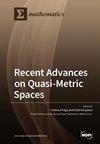New Geometric Theorems Derived from Integral Equations Applied to Radiative Transfer in Spherical Sectors and Circular Segments
IF 2.3
3区 数学
Q1 MATHEMATICS
引用次数: 0
Abstract
Semicircles and circular sectors are both ubiquitous in the natural realm. However, mathematically speaking they have represented an enigma since antiquity. In recent years, the author has worked in integral equations with sections of spheres as related to radiative heat transfer and their associated form factors, to the point of defining new postulates. The main theorems thus far enunciated refer to the radiative exchange between circles and half disks, but recently the possibility to treat circular sectors has arrived, thanks to the research already conducted. As is known, to find the exact expression of the configuration factor by integration is complex. In the above mentioned problem of the circular sectors, the author reached the first two steps of the basic formulation for radiant exchange. Subsequently, the novelty of the procedure lies in introducing a finite differences approach for the third and fourth integrals which still remain unsolved, once we have been able to find the preliminary integrals. This possibility had not been identified by former research and the output provides us with an ample variety of unexpected scenarios. As a consequence, we are able to analyze with more precision the spatial transference of radiant heat for figures composed of circular sectors. We already know that spherical shapes cannot be discretized with any accuracy. Therefore, we would be able to reduce a considerable amount of hindrance in the progress of thermal radiation science. Important sequels will be derived for radiation in the entrance to tunnels, aircraft design and lighting as well.从积分方程衍生出的新几何定理应用于球面扇形和圆形部分的辐射传输
半圆和圆扇形在自然界中无处不在。然而,从数学角度看,它们自古以来就是一个谜。近年来,作者研究了与辐射传热有关的球面截面积分方程及其相关的形式因子,甚至定义了新的定理。到目前为止,所阐述的主要定理都是关于圆和半盘之间的辐射交换,但最近,由于已经开展的研究,已经有了处理圆形截面的可能性。众所周知,通过积分找到构型因子的精确表达是非常复杂的。在上述圆形扇形问题中,作者完成了辐射交换基本公式的前两步。随后,该程序的新颖之处在于,一旦我们能够找到初步积分,就可以引入有限差分方法来求解第三和第四个积分,而这两个积分仍未解决。以前的研究没有发现这种可能性,其结果为我们提供了大量意想不到的情况。因此,我们能够更精确地分析由圆形扇形组成的图形的辐射热空间传递。我们已经知道,球形无法精确离散化。因此,我们将能够减少热辐射科学发展过程中的大量障碍。在隧道入口辐射、飞机设计和照明方面,我们也将得出重要的后续结论。
本文章由计算机程序翻译,如有差异,请以英文原文为准。
求助全文
约1分钟内获得全文
求助全文
来源期刊

Mathematics
Mathematics-General Mathematics
CiteScore
4.00
自引率
16.70%
发文量
4032
审稿时长
21.9 days
期刊介绍:
Mathematics (ISSN 2227-7390) is an international, open access journal which provides an advanced forum for studies related to mathematical sciences. It devotes exclusively to the publication of high-quality reviews, regular research papers and short communications in all areas of pure and applied mathematics. Mathematics also publishes timely and thorough survey articles on current trends, new theoretical techniques, novel ideas and new mathematical tools in different branches of mathematics.
 求助内容:
求助内容: 应助结果提醒方式:
应助结果提醒方式:


